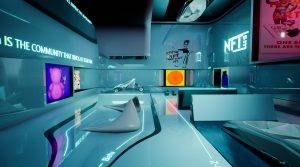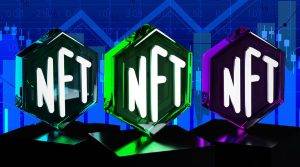How NFT Interoperability Can Foster Collaboration and Innovation

How NFT Interoperability Can Foster Collaboration and Innovation
In recent years, Non-Fungible Tokens (NFTs) have gained significant attention in the world of digital assets. These unique tokens, built on blockchain technology, have revolutionized various industries, including art, gaming, and collectibles. However, as the NFT ecosystem continues to expand, the need for interoperability arises. In this article, we will explore how NFT interoperability can foster collaboration and innovation within the digital asset space.
Introduction
NFTs have brought about a paradigm shift in how we perceive and exchange digital assets. These tokens represent ownership and authenticity of unique items in the digital realm, such as artwork, music, virtual real estate, and more. However, the lack of interoperability between different blockchain networks has limited the full potential of NFTs.
Understanding NFT Interoperability
NFT interoperability refers to the ability of tokens to seamlessly interact and function across multiple blockchain platforms. Currently, most NFTs are specific to a particular blockchain, which restricts their mobility and utility. Interoperability aims to break down these barriers by enabling NFTs to be transferred and used across different networks.
NFT interoperability refers to the ability of Non-Fungible Tokens (NFTs) to function and interact seamlessly across multiple blockchain networks. Currently, NFTs are often specific to a particular blockchain, limiting their mobility and utility. Interoperability aims to break down these barriers by enabling NFTs to be transferred, used, and accessed across different chains. It allows NFTs to retain their unique attributes and ownership while being compatible with various platforms. NFT interoperability opens up new opportunities for collaboration, expands market reach, fosters innovation, and ensures the portability of digital assets in the ever-evolving landscape of blockchain technology.
Benefits of NFT Interoperability
Enhancing Cross-Platform Collaboration
NFT interoperability opens up opportunities for collaboration between artists, developers, and creators from various ecosystems. Artists can collaborate on cross-chain projects, combining their unique styles and skills to create groundbreaking digital experiences. Developers can leverage the strengths of different blockchains to enhance the functionality and utility of NFTs.
Expanding Market Reach
Interoperability allows NFTs to reach a wider audience by bridging different blockchain communities. Artists and creators can tap into multiple markets and attract diverse collectors, expanding their exposure and potential revenue streams. Furthermore, collectors can explore a broader range of NFT offerings, regardless of the blockchain they are originally associated with.
Fostering Innovation and Creativity
By enabling interoperability, NFTs become building blocks for innovation and creativity. Artists can experiment with combining different assets and functionalities from various blockchains, pushing the boundaries of what is possible in the digital art space. This collaborative environment fosters the development of unique and groundbreaking NFT projects.
Overcoming Scalability Challenges
Blockchain scalability has been a concern within the NFT space, with network congestion and high transaction fees hindering widespread adoption. Interoperability can alleviate these challenges by distributing the load across multiple blockchains. This enables faster transaction processing and reduces congestion, providing a smoother and more efficient experience for NFT creators and collectors.
Ensuring Asset Portability
NFT interoperability ensures that assets are not confined to a single blockchain ecosystem. It allows owners to move their NFTs between platforms, providing greater flexibility and control over their digital assets. This portability reduces the risk of platform dependency and enhances the long-term value and liquidity of NFT investments.

Promoting Standardization and Compatibility
NFT interoperability also encourages the development of industry standards and compatibility frameworks. As different blockchain networks work together to enable interoperability, they need to establish common protocols and standards for seamless asset transfer. This collaboration drives the industry forward, setting the stage for widespread adoption and integration of NFTs.
NFT Interoperability Projects and Initiatives
Several projects and initiatives are already underway to facilitate NFT interoperability. Some prominent examples include:
- Polygon (formerly Matic):
- Polygon aims to create a multi-chain ecosystem.
- Enables seamless transfer of NFTs between Ethereum and Polygon networks.
- Provides scalability and reduced transaction fees for NFT transactions.
- Polkadot and Kusama:
- These interoperable blockchains offer a framework for building NFTs.
- NFTs can interact with multiple chains within the Polkadot ecosystem.
- Facilitates cross-chain asset transfers and interoperability.
- Flow:
- Flow blockchain focuses on scalability and interoperability.
- Simplifies the creation of NFT experiences across multiple applications.
- Supports a wide range of digital assets, including NFTs.
- Cosmos:
- Cosmos aims to create an interoperable and scalable blockchain ecosystem.
- Allows for the transfer of NFTs between different chains within the Cosmos network.
- Provides a framework for building cross-chain applications.
- Wanchain:
- Wanchain is a decentralized blockchain platform focused on interoperability.
- Enables the transfer of NFTs and other digital assets between different blockchains.
- Supports cross-chain smart contracts and decentralized applications (dApps).
- Binance Smart Chain:
- Binance Smart Chain (BSC) offers interoperability features.
- Allows for the transfer of NFTs between BSC and Ethereum networks.
- Provides developers with tools and resources to build NFT projects on the BSC network.
- Harmony:
- Harmony is a high-throughput blockchain platform.
- Enables interoperability through the Harmony Bridge protocol.
- Allows for the transfer of NFTs between Harmony and Ethereum networks.
- Avalanche:
- Avalanche is a scalable and interoperable blockchain platform.
- Supports the transfer of NFTs between different chains within the Avalanche network.
- Provides developers with tools and resources to build cross-chain NFT applications.
- Ethereum Layer-2 Solutions:
- Layer-2 solutions such as Optimism, Arbitrum, and Loopring aim to enhance scalability and interoperability on the Ethereum network.
- These solutions enable faster and more cost-effective NFT transactions across Ethereum-compatible chains.
- Interoperability Standards and Protocols:
- Various interoperability standards and protocols, such as ERC-998, ERC-1155, and ERC-721x, facilitate NFT interoperability.
- These standards define the rules and specifications for creating cross-chain NFTs and ensure compatibility between different blockchain networks.
These projects and initiatives are actively working towards achieving seamless NFT interoperability, enabling users to leverage the benefits of cross-chain asset transfers and collaboration within the digital asset space.
Potential Challenges and Solutions
While NFT interoperability brings numerous benefits, it also presents challenges. Some of these challenges include:
- Security and Standards:
- Challenge: Ensuring the security of cross-chain transactions and asset transfers.
- Solution: Develop robust security measures, including cryptographic protocols and auditing mechanisms, to protect NFTs during interoperability processes. Establish industry-wide standards for secure cross-chain transfers.
- Technical Complexity:
- Challenge: Addressing the technical complexities associated with interoperability.
- Solution: Foster collaboration between blockchain networks to develop interoperability protocols and frameworks that simplify the process of transferring NFTs between chains. Invest in research and development to create user-friendly tools and interfaces for cross-chain interactions.
- User Experience:
- Challenge: Improving the user experience when interacting with cross-chain NFTs.
- Solution: Design intuitive and user-friendly interfaces that abstract the complexity of cross-chain transactions. Provide seamless experiences for users to transfer, trade, and interact with NFTs across different blockchain networks.
- Interoperability Standards:
- Challenge: Establishing common standards for seamless asset transfer.
- Solution: Collaborate with industry stakeholders to develop interoperability standards and protocols that ensure compatibility and facilitate the transfer of NFTs between different blockchain networks. Promote the adoption of these standards across the ecosystem.
- Scalability:
- Challenge: Addressing scalability challenges associated with increased NFT adoption.
- Solution: Explore layer-2 solutions and sidechains to enhance the scalability of blockchain networks, enabling faster and more efficient cross-chain NFT transfers. Invest in research and development to improve the throughput and capacity of blockchain networks.
- Education and Awareness:
- Challenge: Increasing education and awareness about NFT interoperability.
- Solution: Conduct educational initiatives, workshops, and conferences to educate stakeholders about the benefits and challenges of NFT interoperability. Promote open dialogue and knowledge sharing within the community to foster a better understanding of interoperability concepts.
- Regulatory Considerations:
- Challenge: Addressing regulatory considerations related to cross-chain NFT transfers.
- Solution: Collaborate with regulatory bodies to establish frameworks and guidelines for compliant cross-chain NFT transactions. Engage in open dialogue with regulators to ensure interoperability aligns with legal and regulatory requirements.
By actively addressing these challenges and implementing appropriate solutions, the NFT ecosystem can unlock the full potential of interoperability, enabling seamless collaboration and innovation within the digital asset space.
The Future of NFT Interoperability
The future of NFT interoperability is promising. As blockchain technology evolves, we can expect more advanced and efficient solutions for cross-chain asset transfers. Interoperability will become a fundamental feature of the NFT ecosystem, driving collaboration, innovation, and widespread adoption.
Conclusion
NFT interoperability holds the key to unlocking the full potential of digital assets. By enabling seamless interactions across different blockchain networks, NFTs can foster collaboration, expand market reach, foster innovation, overcome scalability challenges, ensure asset portability, and promote standardization. With ongoing efforts and advancements in interoperability, we are witnessing an exciting era of collaboration and innovation within the NFT space.
FAQ
1. How does NFT interoperability benefit artists?
NFT interoperability allows artists to collaborate with creators from different blockchain ecosystems, expanding their reach and exposure. It also enables artists to experiment with new functionalities and combine assets from various chains, fostering innovation and creativity.
2. Can NFTs be transferred between different blockchain networks?
With interoperability, NFTs can be seamlessly transferred between different blockchain networks, allowing for increased mobility and utility.
3. What are some challenges associated with NFT interoperability?
Challenges include security and standards, technical complexities, and improving the user experience. However, ongoing research and collaboration are addressing these challenges to pave the way for seamless NFT interoperability.
4. How can NFT interoperability enhance market reach for collectors?
Interoperability enables collectors to explore NFT offerings from various blockchain networks, expanding their options and opportunities. They can engage with a broader range of artists and creators, diversifying their collections.
5. What is the future of NFT interoperability?
The future of NFT interoperability looks promising, with ongoing advancements and collaborations. As blockchain technology evolves, we can expect more efficient and user-friendly solutions for seamless cross-chain asset transfers.

I’m known as one of the best crypto authors because I take time to understand the technology and write in a way that is easy for others to understand. I can simplify complex concepts and my writing style is engaging. My articles have been featured on some of the top crypto sites and I’mregularly sought out by readers for my insights on the latest news. I’m also a speaker and have discussed crypto at various conferences. If you’re looking for someone who can help you make sense of the ever-changing world of cryptocurrency, then you can get in touch with me.



